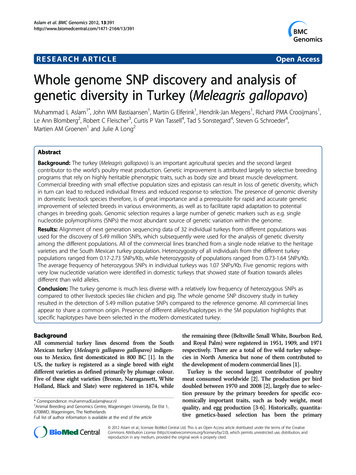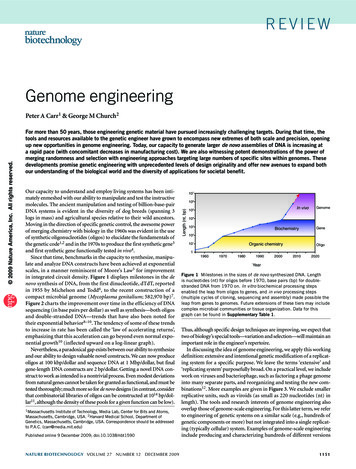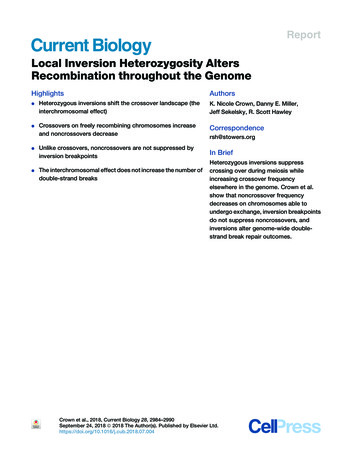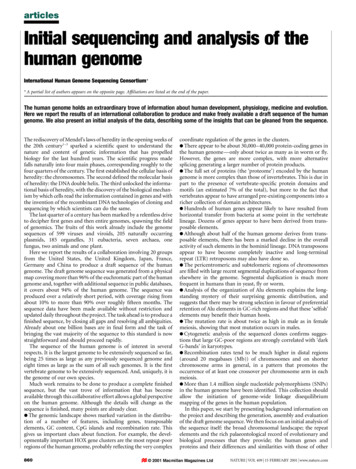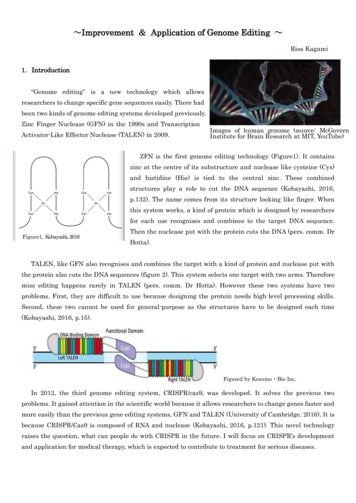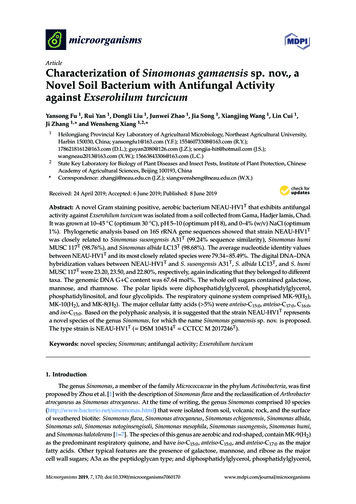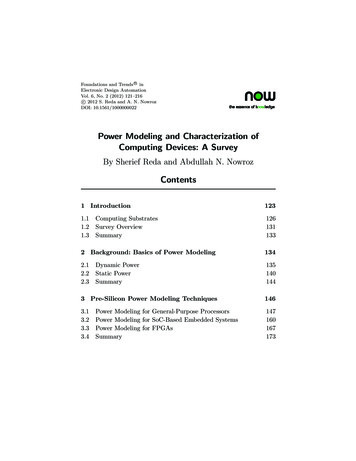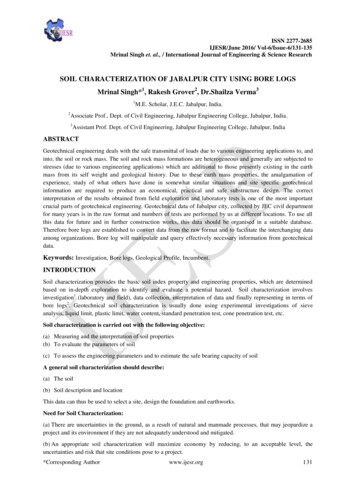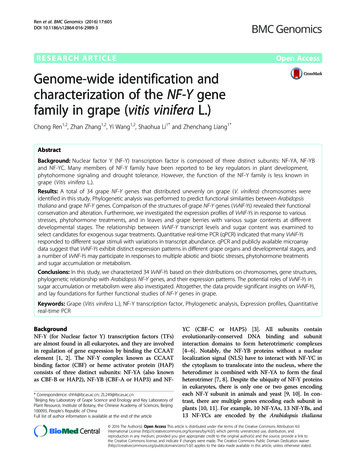
Transcription
Ren et al. BMC Genomics (2016) 17:605DOI 10.1186/s12864-016-2989-3RESEARCH ARTICLEOpen AccessGenome-wide identification andcharacterization of the NF-Y genefamily in grape (vitis vinifera L.)Chong Ren1,2, Zhan Zhang1,2, Yi Wang1,2, Shaohua Li1* and Zhenchang Liang1*AbstractBackground: Nuclear factor Y (NF-Y) transcription factor is composed of three distinct subunits: NF-YA, NF-YBand NF-YC. Many members of NF-Y family have been reported to be key regulators in plant development,phytohormone signaling and drought tolerance. However, the function of the NF-Y family is less known ingrape (Vitis vinifera L.).Results: A total of 34 grape NF-Y genes that distributed unevenly on grape (V. vinifera) chromosomes wereidentified in this study. Phylogenetic analysis was performed to predict functional similarities between Arabidopsisthaliana and grape NF-Y genes. Comparison of the structures of grape NF-Y genes (VvNF-Ys) revealed their functionalconservation and alteration. Furthermore, we investigated the expression profiles of VvNF-Ys in response to variousstresses, phytohormone treatments, and in leaves and grape berries with various sugar contents at differentdevelopmental stages. The relationship between VvNF-Y transcript levels and sugar content was examined toselect candidates for exogenous sugar treatments. Quantitative real-time PCR (qPCR) indicated that many VvNF-Ysresponded to different sugar stimuli with variations in transcript abundance. qPCR and publicly available microarraydata suggest that VvNF-Ys exhibit distinct expression patterns in different grape organs and developmental stages, anda number of VvNF-Ys may participate in responses to multiple abiotic and biotic stresses, phytohormone treatmentsand sugar accumulation or metabolism.Conclusions: In this study, we characterized 34 VvNF-Ys based on their distributions on chromosomes, gene structures,phylogenetic relationship with Arabidopsis NF-Y genes, and their expression patterns. The potential roles of VvNF-Ys insugar accumulation or metabolism were also investigated. Altogether, the data provide significant insights on VvNF-Ys,and lay foundations for further functional studies of NF-Y genes in grape.Keywords: Grape (Vitis vinifera L.), NF-Y transcription factor, Phylogenetic analysis, Expression profiles, Quantitativereal-time PCRBackgroundNF-Y (for Nuclear factor Y) transcription factors (TFs)are almost found in all eukaryotes, and they are involvedin regulation of gene expression by binding the CCAATelement [1, 2]. The NF-Y complex known as CCAATbinding factor (CBF) or heme activator protein (HAP)consists of three distinct subunits: NF-YA (also knownas CBF-B or HAP2), NF-YB (CBF-A or HAP3) and NF* Correspondence: shhli@ibcas.ac.cn; ZL249@ibcas.ac.cn1Beijing Key Laboratory of Grape Science and Enology and Key Laboratory ofPlant Resource, Institute of Botany, the Chinese Academy of Sciences, Beijing100093, People’s Republic of ChinaFull list of author information is available at the end of the articleYC (CBF-C or HAP5) [3]. All subunits containevolutionarily-conserved DNA binding and subunitinteraction domains to form heterotrimeric complexes[4–6]. Notably, the NF-YB proteins without a nuclearlocalization signal (NLS) have to interact with NF-YC inthe cytoplasm to translocate into the nucleus, where theheterodimer is combined with NF-YA to form the finalheterotrimer [7, 8]. Despite the ubiquity of NF-Y proteinsin eukaryotes, there is only one or two genes encodingeach NF-Y subunit in animals and yeast [9, 10]. In contrast, there are multiple genes encoding each subunit inplants [10, 11]. For example, 10 NF-YAs, 13 NF-YBs, and13 NF-YCs are encoded by the Arabidopsis thaliana 2016 The Author(s). Open Access This article is distributed under the terms of the Creative Commons Attribution 4.0International License (http://creativecommons.org/licenses/by/4.0/), which permits unrestricted use, distribution, andreproduction in any medium, provided you give appropriate credit to the original author(s) and the source, provide a link tothe Creative Commons license, and indicate if changes were made. The Creative Commons Public Domain Dedication o/1.0/) applies to the data made available in this article, unless otherwise stated.
Ren et al. BMC Genomics (2016) 17:605genome [1, 10]. This expansion is a common feature inthe plant kingdom, and it helps plants form flexible, versatile TF systems to accommodate complex and diverseenvironment conditions [11].As a kind of combinatorial TFs, NF-Ys have been reported to be involved in regulation of plant developmentand respond to various abiotic and biotic stresses [12–19].The Arabidopsis LEAFY COTYLEDON 1 (LEC1, AtNFYB9) is the first cloned and well-known plant NF-Ygene, and it has been proven that LEC1 is a pivotalregulator in embryogenesis [12, 13, 20, 21]. Recently,the NF-Y genes are also found to be involved in response to endoplasmic reticulum (ER) stress [22, 23].Grape (Vitis spp.) is cultivated worldwide and has tremendous economic value, and a few reports haveemerged revealing the role of VvL1L in grape [24, 25].However, the function of the overwhelming majority ofNF-Y genes in grape is still poorly understood, despitethe conservation of functional amino acid residuesacross different species [26–28].To explore and characterize the potential functions ofgrape NF-Y genes (VvNF-Ys), we adopted bioinformaticsto analyze the 34 identified VvNF-Ys (8 NF-YAs, 18NF-YBs, 8 NF-YCs) based on publicly available data.Furthermore, we investigated the expression patternsof VvNF-Ys in response to different biotic and abioticstresses, exogenous phytohormone, and sugar treatments. In addition, the expression profiles of VvNF-Ysin grape berries were examined at different developmental stages. The phylogenetic analysis of NF-Ysfrom grape and Arabidopsis, investigation of proteinmotif and exon-intron structure patterns, and the experimental data provide insights on the function ofVvNF-Ys. Taken together, our results provide a set ofcandidate NF-Y genes for future study and geneticmodification in grape.ResultsIdentification and characterization of grape NF-Y genesNF-Y proteins were identified by searching the PlantTranscription Factor Database (PlantTFDB, http://planttfdb.cbi.pku.edu.cn/) and the UniProt database(http://www.uniprot.org/) using the PFAM and KOGIDs of conserved domains. Then, a BLAST search ofthe 12 grape genome was performed using fulllength amino acid sequences of candidate NF-Y genes.By removing incomplete and redundant sequences, 34NF-Y genes were identified, including 8 NF-YA, 18NF-YB, and 8 NF-YC genes (Table 1). The 34 VvNFYs were named based on their distribution and relative distance on grape chromosomes. Thirty-twoVvNF-Ys could be mapped on 14 grape chromosomeswith the exception of VvNF-YB17 and VvNF-YB18(Table 1 and Additional file 1: Figure S1). AmongPage 2 of 16these chromosomes, four possessed only one NF-Y gene,and seven possessed two NF-Y genes. Chromosomes 6 and19 had five NF-Y genes, most of which were concentratedin the upper part of the chromosomes (Additional file 1:Figure S1). Uneven and variable distribution of VvNF-Yson grape chromosomes is consistent with the results ofprevious reports [3, 29].Characteristics of the 34 VvNF-Ys are shown in Table 1.Significant difference of the length of VvNF-Y sequenceswas observed, with a range from 351 to 51,220 bp, andthe difference results in variability of predicted aminoacid numbers. The exon-intron structures of VvNF-Yswere also analyzed (Additional file2: Figure S2). Theexon-intron organization could indicate the evolutionaryrelationships within multi-gene families [30]. Most ofVvNF-YAs had five or six exons and four or five intronsand their intron phases occurred in the same pattern except for VvNF-YA1 and VvNF-YA8. The structures ofVvNF-YBs and VvNF-YCs were more variable and complicated, and the two families shared similar exon-intronorganization (Additional file 2: Figure S2). The resultswere consistent with the previous report [29].Phylogenetic analysis and multiple alignment of NF-Yprotein sequencesTo investigate the evolutionary relationship and functional association of VvNF-Ys with Arabidopsis NF-Yfamily, we constructed an unrooted phylogenetic treeusing the protein sequences of NF-Ys from grape andArabidopsis (Fig. 1). The phylogenetic analysis showedthat the 34 VvNF-Ys were divided into three groups(Fig. 1). Almost all the members of VvNF-YAs, VvNF-YBsor VvNF-YCs were clustered into the same sub-branchexcept for VvNF-YC3. Three pairs of NF-YAs, four pairsof NF-YBs and one pair of NF-YCs showed high similarity in sequence, respectively (Fig. 1). Most of VvNF-Yshad homologs in Arabidopsis. The phylogenetic relationship indicated basal architecture conservation and possible functional similarities of NF-Y family betweengrape and Arabidopsis.Multiple sequence alignments of NF-Y proteins fromgrape, Arabidopsis, human (Homo sapiens), mouse (Rattusnorvegicus) and yeast (Saccharomyces cerevisiae) weregenerated. NF-YA proteins which lack distinct homologyto other annotated proteins [30] were characterized bytwo conserved domains: the DNA-binding domain andthe subunit interaction domain [31, 32]. The two domainswere conserved among plants and other eukaryote organisms (Fig. 2). The amino acid residues required for functionality in most mammals and yeast [31, 32] were presentin grape NF-YA proteins (Fig. 2a). The conservation offunctionality required amino acid residues across differenteukaryote lineages strongly suggests functional conservation [1]. As with NF-YA proteins, NF-YBs and NF-YCs
Ren et al. BMC Genomics (2016) 17:605Page 3 of 16Table 1 NF-Y transcription factors in grapeNameGene IDBest match in ArabidopsisChr.StrandGenomic (bp)No. of aapINF-YA1GSVIVT01036936001At1g314202 5122016118.89NF-YA2GSVIVT01025252001At5g12840, AtNF-YA16 71003066.49NF-YA3GSVIVT01033313001At3g20910, AtNF-YA98 56393548.67NF-YA4GSVIVT01022601001At5g06510, 830, AtNF-YA39 75413369.15NF-YA6GSVIVT01021622001At1g30500, AtNF-YA710 146792087.17NF-YA7GSVIVT01015120001At3g14020, AtNF-YA611 29723108.76NF-YA8GSVIVT01032101001At3g20910, 030, AtNF-YB41 4591525.78NF-YB2GSVIVT01010264001At1g09030, AtNF-YB41 4591528.87NF-YB3GSVIVT01017741001At2g47810, 0, AtNF-YB116 82801935.59NF-YB5GSVIVT01025110001At3g53340, 9507 8762919.07NF-YB7GSVIVT01010959001At2g47810, AtNF-YB57 3871286.84NF-YB8GSVIVT01025539001At2g37060, AtNF-YB88 24361615.81NF-YB9GSVIVT01030085001At4g1273012 71254825.93NF-YB10GSVIVT01016347001At2g37060, AtNF-YB813 46821766.42NF-YB11GSVIVT01031089001At1g09030, AtNF-YB414 4441476.83NF-YB12GSVIVT01008215001At5g23090, 5566019 1164410986.36NF-YB14GSVIVT01014673001At5g47640, AtNF-YB219 17112106.44NF-YB15GSVIVT01014689001At5g47670, AtNF-YB619 14022095.89NF-YB16GSVIVT01014690001At5g47670, AtNF-YB619 15372155.48NF-YB17GSVIVT01004375001At4g14540, AtNF-YB3Un 13761144.10NF-YB18GSVIVT01002895001At5g47670, 830, AtNF-YC32 3511169.46NF-YC2GSVIVT01017901001At1g08970, AtNF-YC95 43581049.10NF-YC3GSVIVT01025169001At1g07980, AtNF-YC106 84374259.72NF-YC4GSVIVT01037394001At3g12480, 480, AtNF-YC1113 151442719.40NF-YC6GSVIVT01030963001At5g63470, 90, 170, AtNF-YC21910721145.06NF-YA SubunitNF-YB SubunitNF-YC Subunitcontained DNA-binding and subunit interaction domainsas well (Fig. 2b, c). The required amino acids were wellconserved in most of grape NF-YB proteins except forNF-YB7 and NF-YB17. The aspartate (D72) which isthought to be significant for protein interactions [28, 33]was conserved in almost all NF-YB proteins (Fig. 2b). Halfof grape NF-YC proteins exhibited residue deletions, andsome residues in NF-YC were replaced by alternative onesof similar properties. However, the arginine (R52) andaspartate (D59) which are necessary for stabilization ofNF-YB/C [28] were present in most NF-YCs (Fig. 2c). Theconservation of protein sequences suggests the conservedfunction while the non-conservative changes would indicate novel functional alterations [1].
Ren et al. BMC Genomics (2016) 17:605Page 4 of 16Fig. 1 Phylogenetic analysis of NF-Y proteins from grape and Arabidopsis thaliana. Thirty-four NF-Y proteins from grape and 36 NF-Y proteins fromArabidopsis were divided into four branches according to subunit type. Red branch indicates NF-YAs, blue branch represents NF-YBs, and two yellowbranches denote NF-YCsExpression patterns of VvNF-Ys in response to abiotic,biotic stresses and phytohormonesNumerous reports have revealed the function of individual NF-Y genes in responses to various biotic and abioticstresses [14, 18, 19, 34, 35]. To further investigate howNF-Y genes response to stresses, expression of VvNF-Ygenes was measured under several stresses. Probe setsfrom Affymetrix GeneChip platform for 16 VvNF-Ys(Additional file 3: Table S1) were successfully obtainedand corresponding genes were selected for further study.We first examined the responsiveness of VvNF-Ys tomultiple abiotic stresses including salt, drought, coldand high temperature by taking advantage of publiclyavailable data. ‘Cabernet Sauvignon’ (Vitis vinifera L.)plants were treated with salt, drought (PEG) and cold(5 C), respectively, and expression of VvNF-Ys was analyzed subsequently. About three VvNF-Ys (1 VvNF-YAand 2 VvNF-YBs) were up- or down-regulated ( 1-fold)to at least one stress treatment (Fig. 3). VvNF-YA3 wasinduced and the transcript level reached a peak of nearly2-fold at 24 h after salt and PEG treatments, whileVvNF-YB18 responded to all the stress treatments andits expression was rapidly suppressed ( 2-fold) at 4 hafter the treatments (Fig. 3a). The difference in expression patterns of VvNF-YA3 and VvNF-YB18 suggeststheir different roles in response to salt and PEG. Forheat treatment, ‘Cabernet Sauvignon’ seedlings derivedfrom stem cuttings were placed at 45 C and then recovered at 25 C [36]. Two VvNF-YBs responded ( 2-fold)to heat stress or the following recovery process (Fig. 3b).The transcript abundance of VvNF-YB18 was increased( 2-fold) in response to heat treatment, whereas theother gene, VvNF-YB9, was down-regulated ( 1-fold)after the heat treatment. However, the transcript level ofVvNF-YB9 was increased ( 2-fold) again during the subsequent recovery process (Fig. 3b). These results showedthat VvNF-YB18 may help enhance the resistance ofgrape to heat stress, and VvNF-YB9 may participate inthe heat recovery process. All the results discussed aboverevealed that some of VvNF-Ys may be associated with
Ren et al. BMC Genomics (2016) 17:605Page 5 of 16Fig. 2 Alignments of grape NF-Y domains. The sequences of grape NF-YAs (a) NF-YBs (b) and NF-YCs (c) were aligned with corresponding referredsequences from Arabidopsis thaliana (At), human (Hs), mouse (Rn) and yeast (Sc), respectively. The actual amino acid numbers of the end of thedomains are shown on the right of the figure. Functionality required amino acids (Required AA) that are verified in rat [44] and yeast [45] aregiven below the sequences. The residual clusters located in the blue boxes are essential for nuclear targeting [64]the signaling of abiotic stress responsiveness. Amongthese genes, VvNF-YB18 responded to various stressesand showed different expression patterns upon thesetreatments, suggesting its different roles in multiplesignaling pathways.We next analyzed the possible involvement of NF-Ygenes in response to biotic stresses. No obvious changes( 1-fold) in expression levels of VvNF-Ys were detected in‘Cabernet Sauvignon’ after powdery mildew fungus (PM)infection (data not shown), and this result is consistentwith a previous report [37]. The expression patterns ofVvNF-Ys after Plasmopara viticola inoculation were alsoanalyzed. Three VvNF-YBs were found to respond ( 2fold) to P. viticola infection (Fig. 4). VvNF-YB13 and
Ren et al. BMC Genomics (2016) 17:605Page 6 of 16Fig. 3 Expression profiles of VvNF-Ys in response to abiotic stress treatments. a Expression patterns of VvNF-Ys in response to salt, drought (PEG)and cold (5 C) treatments. b Expression patterns of VvNF-Ys under heat stress treatment. HT represents high temperature and RC means recoveryprocess. The color scale indicates fold-change values (log2 values) with red representing increased transcript abundance and green indicatingdecreased transcript abundance. A red box indicates up-regulation and blue box indicates down-regulationVvNF-YB17 were down-regulated in incompatible plantbearing the resistant gene Rpv2 after P. viticola infectionas compared to the mock control. The expression level ofVvNF-YB18 in resistant plants (bearing Rpv1 or Rpv2) wasincreased after inoculation (Fig. 4). These results indicatedthat a certain number of VvNF-Ys displayed pathogenrelated expression patterns, implying their possible involvement in grape immune signaling. Those VvNF-Yswith altered expression levels might be candidates forfurther study of grape immune response.Fig. 4 Expression patterns of VvNF-Ys during downy mildew infection. Plants of different genotypes were used in the experiment: susceptibleplants without resistance loci Rpv1 and Rpv2 (Rpv1 ( ) Rpv2 ( )) and incompatible plants bearing the resistance gene Rpv1 (Rpv1 ( ) Rpv2 ( ))or Rpv2 (Rpv1 ( ) Rpv2 ( )). PI means Plasmopara viticola inoculation. The color scale indicates fold-change values (log2 values) with red representingincreased transcript abundance and green indicating decreased transcript abundance. A red box indicates up-regulation and blue boxindicates down-regulation
Ren et al. BMC Genomics (2016) 17:605Phytohormones such as abscisic acid (ABA), methyljasmonate (MJ), salicylic acid (SA), and ethylene havebeen reported to act as messengers in plant response toabiotic and biotic stresses [38]. To examine the influenceof phytohormones on VvNF-Ys expression, we analyzedthe transcript levels of VvNF-Ys in ‘Monastrell’ (V. vinifera) calli in response to exogenously applied MJ and cyclodextrin elicitor (CD). As shown in Fig. 5a, VvNF-YA7showed a decreased transcript level ( 1-fold) whereasVvNF-YA8 showed an increased transcript level ( 1-fold)in response to exogenous MJ and CD. For ABA treatment, grapevines of ‘Cabernet Sauvignon’ at veraisonwere treated with 400 mg/L ABA solution. Two VvNFYs (1 VvNF-YA and 1 VvNF-YB) showed a decrease intranscript abundance upon exogenous ABA treatment(Fig. 5b). In contrast to treatments with MJ and CD,VvNF-YA8 was slightly down-regulated (0.5-fold) uponABA treatment at 28 day after veraison (dav). The expression of VvNF-YB18, however, was repressed ( 1fold) by exogenous ABA at 14 dav. The possible functionof VvNF-YB18 in ABA signaling pathway may partlyaccount for its involvement in response to abiotic andbiotic stresses.Expression profiles of VvNF-Ys in grape leaves and berriesat different development stagesTo investigate expression patterns of VvNF-Ys in two ofthe most important grape organs, leaves and berries,quantitative real-time PCR (qPCR) was conducted toanalyze VvNF-Y expression in leaves (L) and berries (F)of ‘Semillon’ (V. vinifera) at veraison (V) and fully ripestage (R) (namely, LV, LR, FV and FR), respectively.However, due to the homogeneous properties of VvNFYs as well as the fact that primers did not work as wellas expected, about half of the VvNF-Ys were selected forPage 7 of 16qPCR analyses, and 13 yielded significant results (Fig. 6a).Generally, the expression levels of VvNF-Ys in leaveswere higher (P 0.01) than that in berries, and most ofVvNF-Ys exhibited higher transcript levels (P 0.05) inLV than in LR (Fig. 6a). For example, VvNF-YB8 wasdifferentially expressed (P 0.01) in leaves, and the transcript level of VvNF-YB8 was much higher (P 0.01) inLV as compared to that in LR (Fig. 6a). This result indicated that VvNF-YB8 might be a tissue-specific gene andparticipate in synthesis-oriented biological processes. Itis notable that the transcript abundance of most VvNFYs exhibited no much difference in berries with the exception being VvNF-YC5, which had a higher expressionlevel (P 0.05) in FR rather than in FV (Fig. 6a). Allthese results suggested that some of VvNF-Ys may be associated with grape development, which is consistentwith the results of RNA-seq (data not shown). qPCRwas conducted to further demonstrate the expressionpatterns of VvNF-Ys in grape berries at three differentdevelopmental stages. More than half of tested VvNF-Yswere predominantly expressed (P 0.01) in specificdevelopment period as expected (Fig. 6b). VvNF-YA7and VvNF-YB14 were differentially expressed at fruit set(FS), while VvNF-YB4 and VvNF-YB8 were dominantlyexpressed at veraison (V). The transcript level of VvNFYB8 was decreased (P 0.01) at the development stageof fully ripe (R). These results indicated that VvNF-Ysmight paly roles throughout the development of grape,and expression of specific genes would be regulated atcertain stages of grape development.Additionally, expression profiles of VvNF-Ys in different berry tissues were also detected [39]. Five VvNF-Ysexhibited different expression patterns in different berrytissues (Fig. 6c). Two VvNF-YAs (VvNF-YA3 and VvNFFYA8) and VvNF-YB13 were differentially expressed ( 2-Fig. 5 Expression patterns of VvNF-Ys in response to phytohormone and elicitor treatment. a Expression patterns of VvNF-Ys in response to methyljasmonate (MJ) and cyclodextrin elicitor (CD). b Expression patterns of VvNF-Ys under ABA treatment. Dav represents days after veraison. The colorscale indicates fold-change values (log2 values) with red representing increased transcript abundance and green indicating decreased transcriptabundance. A red box indicates up-regulation and blue box indicates down-regulation
Ren et al. BMC Genomics (2016) 17:605Fig. 6 (See legend on next page.)Page 8 of 16
Ren et al. BMC Genomics (2016) 17:605Page 9 of 16(See figure on previous page.)Fig. 6 Expression profiles of VvNF-Ys in grape leaves and berries at different developmental stages. a Detailed expression levels of VvNF-Ys in grapeleaves and berries. LV and LR denote leaves at veraison (V) and fully ripe (R) while FV and FR represent berries at V and R, respectively. b Detailedexpression levels of VvNF-Ys in grape berries at three different developmental stages: fruit set (FS), V and R. c Expression patterns of VvNF-Ys indifferent berry tissues. WW and WD mean well-watered and water-deficit conditions, respectively. Grape Actin1and UBC were used as internalcontrols of quantitative real-time PCR analysis. The data are presented as mean values SD. * and ** represent statistically significant (P 0.05)and highly significant (P 0.01) differences, respectively. Significance of values in (a) was based on comparison of expression levels in leavesand berries at different stages with expression levels in leaves at V while in (b) was based on comparison of expression levels in berries at Vand R with expression levels in berries at FSfold) in seed, and VvNF-YB9 as well as VvNF-YC2 waspredominantly expressed ( 1.5-fold) in pulp and skin(Fig. 6c). Notably, the expression of VvNF-YB9 in pulpand skin was affected ( 1.5-fold) by water supply, suggesting its possible role in response to water deficiency.Expression of VvNF-Ys in response to different sugarcontent and exogenous sugar treatmentThe expression levels of some VvNF-Ys were increasedin grape berries at veraison, which is characterized bythe accumulation of hexose sugar in flesh and skin [40].To examine whether there exists a relationship betweenexpression of VvNF-Ys and sugar content, we firstinvestigated the expression levels of VvNF-Ys in fivegrape varieties with different sugar contents (Fig. 7). Thecontent of glucose, sucrose and fructose was measured,respectively, and sucrose was omitted from the analysisbecause of its extremely low content. Besides, the content of glucose was close to that of fructose (data notshown), so fructose and total sugar were finally chosento evaluate the correlation between sugar content andVvNF-Ys expression. There were four VvNF-Ys (1VvNF-YA, 1 VvNF-YB and 2 VvNF-YCs) changing theirexpression with the contents of fructose in all varieties.Interestingly, variation of expression levels of mostVvNF-Ys was consistent with that of fructose contentsFig. 7 Expression levels of VvNF-Ys and fructose content in different grape varieties. VvNF-YAs (a) VvNF-YBs (b) and VvNF-YCs (c) are divided intothree groups. Soluble sugars were extracted from five grape varieties (S1-S5) and then analyzed by HPLC with water as eluent. The fructosecontent was relatively stable in three successive years (unpublished data), so values for 1 year are given as reference. Black broken lines denotetranscript levels of NF-Y genes, and green broken lines indicate fructose content in grape berries
Ren et al. BMC Genomics (2016) 17:605in at least four grape varieties (Fig. 7). However, thissugar-related expression pattern of VvNF-Ys no longerexist if examined with total sugar contents (Additionalfile 4: Figure S3). These results suggested that a numberof VvNF-Ys, such as VvNF-YA7, VvNF-YB4 and VvNFYC2, may tend to be responsive to specific sugars.To verify the hypothesis that some VvNF-Ys could respond to specific sugar, we analyzed the expression patterns of VvNF-Ys in ‘Chardonnay’ (V. vinifera) suspensioncells after treatment with exogenous glucose, sucrose andfructose at a final concentration of 0.0 (CK), 0.5, 1.0, or2.0 % (w/v), respectively. In general, all the tested VvNF-Yscould be induced (P 0.01) by exogenous fructose exceptfor VvNF-YC8 (Fig. 8), and most VvNF-Ys were downregulated (P 0.05) in response to glucose and sucrosetreatments (Fig. 8). The expression of VvNF-YA1 andVvNF-YB7, however, was induced (P 0.01) by sucrosetreatment (Fig. 8a–b). Additionally, the expression ofVvNF-YB7 was also induced by glucose (Fig. 8b). Intriguingly, 11 out of 14 VvNF-Ys responded strongly to thefructose treatment at the final concentration of 0.5 %with their transcript levels increasing from 1.3-fold(VvNF-YC8) to more than 10-fold (VvNF-YA6). Nevertheless, some of them, i.e. VvNF-YA7, VvNF-YB14,VvNF-YB15 and VvNF-YC6, exhibited decreased transcript levels (P 0.05) at high concentration (1.0 and2.0 %) of fructose (Fig. 8). These data showed that areasonable number of VvNF-Ys displayed sugar-responsiveexpression pattern and their expression may be affectedby the kind and concentration of exogenous sugars.The two VvNF-Ys (VvNF-YA1 and VvNF-YB7) inducedby sucrose could be involved in the biosynthesis and/or transport of sucrose in grape. The expression ofVvNF-YA1 and VvNF-YB7 was promoted after exposure to fructose and glucose, respectively, indicatingtheir potential roles in accumulation of these two solublesugars during grape ripening.DiscussionNF-Y proteins have been revealed to be key factors inmultiple physiological processes in plants [12, 13, 24, 25,41, 42]. However, the function of most NF-Y proteins ingrape are still unknown. Here we tried to take advantageof available data to explore and analyze the grape NF-Yfamily. Based on the results obtained from searching theUniprot database by using PFAM and KOG IDs ofconserved domains, we identified 32 previously predictedNF-Y proteins in PlantTFDB and two more members(Table 1). The two proteins, VvNF-YA1 and VvNF-YB13,consisted of more than 1000 amino acids, and their corresponding genes contained 13 and 11 exons, respectively(Additional file 2: Figure S2). Sequence analysis in InterPro revealed that VvNF-YA1 contained multiple functional domains, and the CBF signature (CBFB/NFYA,Page 10 of 16PFAM02045) was located between glutamic (E1510) andphenylalanine (F1572) next to the N-terminus. VvNF-YB13contained only two domains, and the CBF domain(CBFD NFYB HMF, PF00808) was located between arginine (R914) and methionine (M979) close to the Nterminus as well. The phylogenetic analysis showed thatVvNF-YA1 was homologous to VvNF-YA6, AtNF-YA4and AtNF-YA7, while VvNF-YB13 was homologous toVvNF-YB14, AtNF-YB2 and AtNF-YB3 (Fig. 1).Altogether, VvNF-YA1 and VvNF-YB13 were regarded asthe members of grape NF-Y family.Evolutionary analysis could be used to predict potential functions of unknown members based on the knownfunctions of those well-studied members of the sameclade [3, 43, 44]. Therefore, an un-rooted phylogenetictree based on sequences of NF-Y proteins from grapeand Arabidopsis were constructed to explore the functions of VvNF-Ys (Fig. 1). For example, AtNF-YB2 andAtNF-YB3, the homologous genes of VvNF-YB13 andVvNF-YB14 in Arabidopsis, were reported to promoteflowering in response to inductive long-day condition[45], so the two VvNF-YBs might play roles in regulationof flowering in grape. More importantly, the genes required for flowering time control were generallyexpressed in leaf vascular tissue [45, 46], and our datashowed that VvNF-YB14 was differentially expressed inleaves (Fig. 6a). This result indicates that VvNF-YB14should be the candidate gene of particular interest forfurther study of flowering time control in grape.Alterations in exon-intron structure or conserved domains would change the function of the gene or protein[1, 47]. Analysis of exon-intron structures revealed thatmost of VvNF-YAs had similar exon-intron organizationpattern whereas VvNF-YBs and VvNF-YCs exhibitedmore variable and complicated structures (Additionalfile 2: Figure S2). Multiple alignments of NF-Y proteinsequences among different species revealed the conservation of functional domains in VvNF-
Ren et al. BMC Genomics (2016) 17:605 DOI 10.1186/s12864-016-2989-3. genome [1, 10]. This expansion is a common feature in the plant kingdom, and it helps plants form flexible, versa-tile TF systems to accommodate complex and diverse environment conditions [11]. As a kind of combinatorial TFs, NF-Ys have been re-
